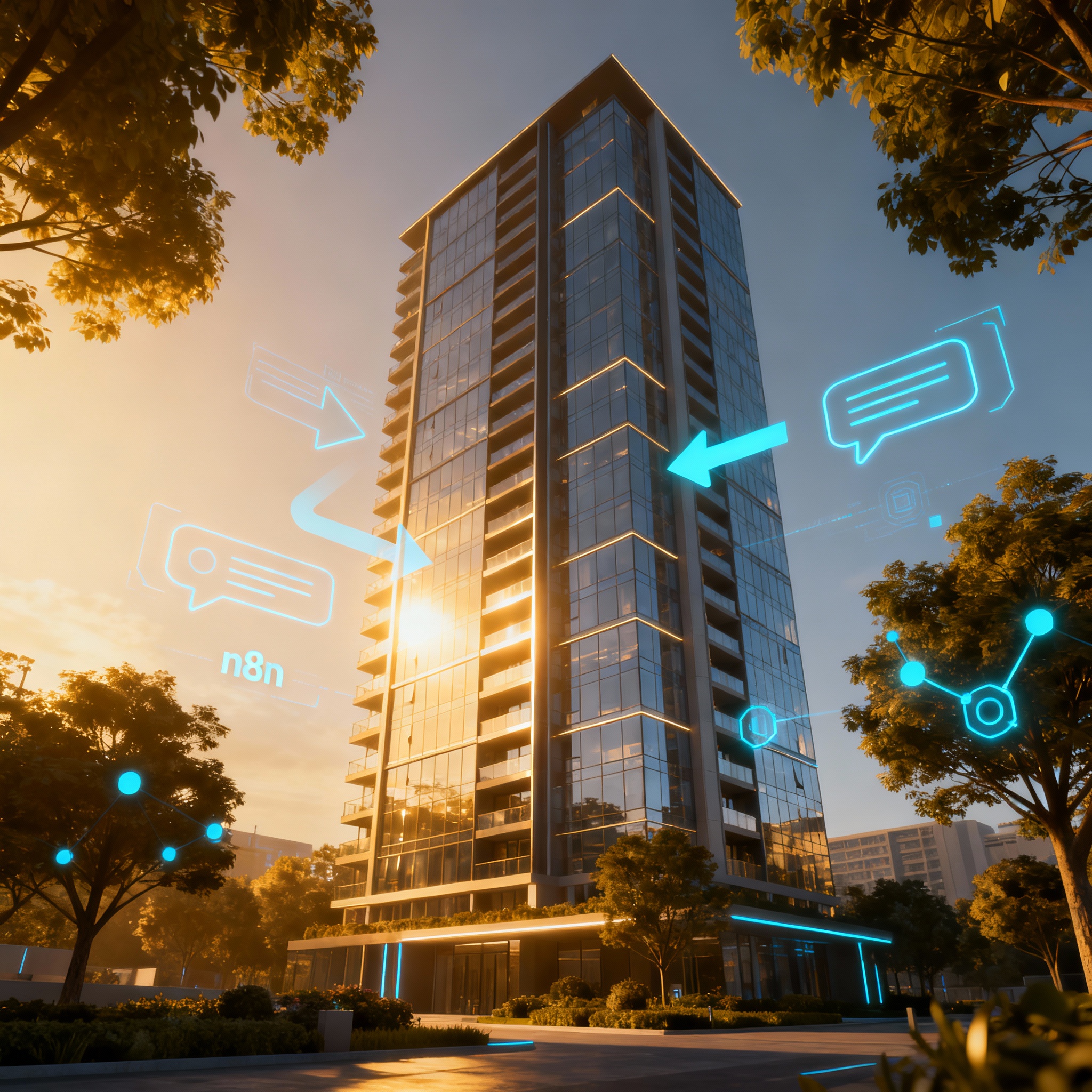Building upon my previous post , this time I’ll demonstrate how to connect n8n with Blender via MCP. By combining n8n’s automation capabilities with Blender’s modeling power, we can drive 3D creation workflows with natural language and AI agents.
Updating to the Latest n8n Image
As mentioned in Automating Workflows with n8n , I’m updating to the latest n8n image and configuring a runner as a sidecar. Task runners provide a secure and performant mechanism to execute tasks.
Here’s my deployment configuration:
# n8n-deployment.yaml
apiVersion: apps/v1
kind: Deployment
metadata:
labels:
io.kompose.service: n8n
name: n8n
namespace: n8n
spec:
replicas: 1
selector:
matchLabels:
io.kompose.service: n8n
strategy:
type: Recreate
template:
metadata:
labels:
io.kompose.service: n8n
spec:
containers:
# Main n8n container
- env:
- name: DB_POSTGRESDB_HOST
value: postgres
- name: DB_POSTGRESDB_PASSWORD
value: postgres
- name: DB_POSTGRESDB_USER
value: postgres
- name: DB_TYPE
value: postgresdb
- name: N8N_DIAGNOSTICS_ENABLED
value: "false"
- name: N8N_PERSONALIZATION_ENABLED
value: "false"
- name: OLLAMA_HOST
value: ollama:11434
# Task runner configuration
- name: N8N_RUNNERS_ENABLED
value: "true"
- name: N8N_RUNNERS_MODE
value: external
- name: N8N_RUNNERS_BROKER_LISTEN_ADDRESS
value: 0.0.0.0
- name: N8N_RUNNERS_AUTH_TOKEN
value: my-n8n-runners-secure-token
- name: N8N_NATIVE_PYTHON_RUNNER
value: "true"
envFrom:
- configMapRef:
name: env
image: n8nio/n8n:1.111.0
imagePullPolicy: Always
name: n8n
ports:
- containerPort: 5678
protocol: TCP
- containerPort: 5679 # Task runner broker port
protocol: TCP
volumeMounts:
- mountPath: /home/node/.n8n
name: n8n-storage
- mountPath: /data/shared
name: n8n-claim2
- mountPath: /demo-data
name: demo-data
# Task runners container
- env:
- name: N8N_RUNNERS_TASK_BROKER_URI
value: http://localhost:5679
- name: N8N_RUNNERS_AUTH_TOKEN
value: my-n8n-runners-secure-token
- name: N8N_RUNNERS_AUTO_SHUTDOWN_TIMEOUT
value: "15"
image: n8nio/runners:1.111.0
imagePullPolicy: Always
name: n8n-runners
volumeMounts:
- mountPath: /data/shared
name: n8n-claim2
hostname: n8n
restartPolicy: Always
volumes:
- name: n8n-storage
persistentVolumeClaim:
claimName: n8n-storage
- name: n8n-claim2
persistentVolumeClaim:
claimName: n8n-claim2
- name: demo-data
persistentVolumeClaim:
claimName: demo-data-pvcDeploy with:
kubectl apply -f n8n-deployment.yaml
kubectl rollout restart deployment n8nAI Agent Chat Workflow
To start, let’s build a simple chat workflow following the AI Agent Chat template . I added the following nodes:
When I tested with:
- My name is seehiong
- Where is Singapore
- Whats my name
…the chat model responded, but it didn’t retain my name.
Adding a Simple Memory node , fixed this—allowing the agent to recall previous messages.
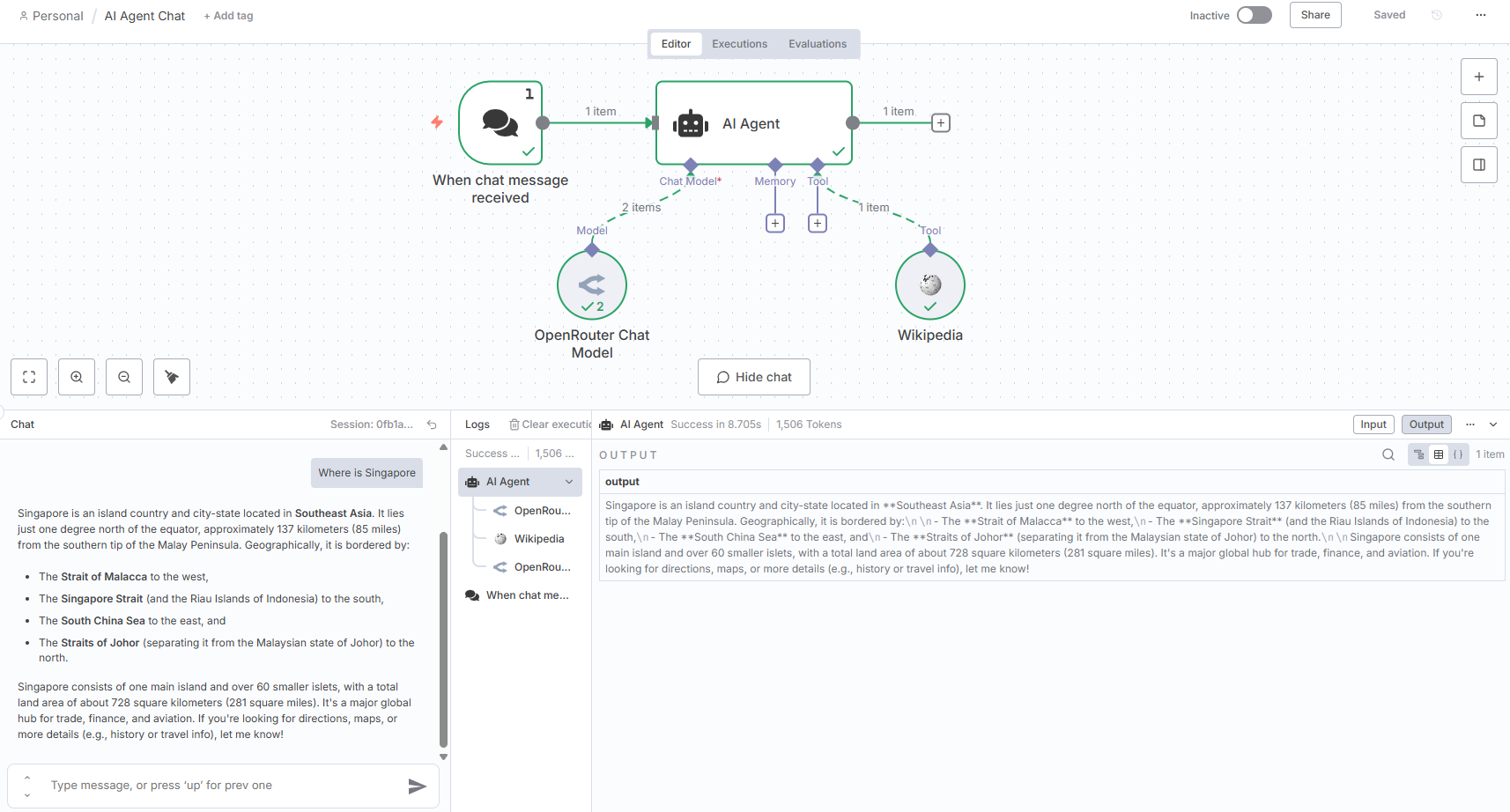
Preparing the Blender Bridge Server
The next step was bridging the AI agent to Blender’s MCP tool. While ideally we’d run uvx blender-mcp directly inside n8n, that would require a custom node. For now, I created a lightweight wrapper service: blender-bridge-server.py.
This service acts as a Fast HTTP-to-MCP bridge, using:
- Persistent connection pooling for low latency
- Structured chat processing with OpenRouter models
- Tool invocation (scene info, object info, code execution)
# blender-bridge-server.py
"""
Fast HTTP-to-MCP Bridge Service for Blender
Uses persistent connections for speed matching original raw TCP client
"""
from flask import Flask, request, jsonify
import asyncio
import os
import json
import threading
import time
import uuid
from datetime import datetime, timedelta
from typing import Dict, List, Optional, Any
from dataclasses import dataclass
import logging
from openai import OpenAI
from dotenv import load_dotenv
import queue
load_dotenv()
# Configuration
@dataclass
class Config:
model: str = os.getenv("MODEL", "openrouter/anthropic/claude-3-sonnet")
blender_host: str = os.getenv("BLENDER_HOST", "127.0.0.1")
blender_port: int = int(os.getenv("BLENDER_PORT", 9876))
openrouter_api_key: str = os.getenv("OPENROUTER_API_KEY")
max_messages: int = 30
session_timeout: int = 1800
temperature: float = 0.0
seed: int = 42
max_connections: int = 20 # Connection pool size
config = Config()
# Logging setup
logging.basicConfig(level=logging.INFO, format='%(asctime)s - %(levelname)s - %(message)s')
logger = logging.getLogger(__name__)
class PersistentMCPConnection:
"""Single persistent connection to Blender MCP"""
def __init__(self, connection_id: str):
self.id = connection_id
self.reader: Optional[asyncio.StreamReader] = None
self.writer: Optional[asyncio.StreamWriter] = None
self.connected = False
self.last_used = time.time()
self.use_count = 0
self._lock = asyncio.Lock()
async def connect(self):
"""Connect to Blender MCP server"""
try:
self.reader, self.writer = await asyncio.wait_for(
asyncio.open_connection(config.blender_host, config.blender_port),
timeout=5
)
self.connected = True
self.last_used = time.time()
logger.info(f"Connection {self.id} established to Blender MCP")
except Exception as e:
self.connected = False
logger.error(f"Connection {self.id} failed: {e}")
raise
async def send_command(self, command: dict) -> dict:
"""Send command using persistent connection"""
async with self._lock:
if not self.connected:
await self.connect()
try:
# Send command
command_json = json.dumps(command)
self.writer.write(command_json.encode('utf-8'))
await self.writer.drain()
# Read response
response_data = await asyncio.wait_for(self.reader.read(8192), timeout=10)
if not response_data:
raise ConnectionError("Empty response")
response = json.loads(response_data.decode('utf-8'))
self.last_used = time.time()
self.use_count += 1
# Handle error responses
if response.get("status") == "error":
raise RuntimeError(f"Blender error: {response.get('message')}")
return response.get("result", response)
except Exception as e:
self.connected = False
logger.error(f"Connection {self.id} command failed: {e}")
raise
async def close(self):
"""Close connection"""
if self.writer and not self.writer.is_closing():
self.writer.close()
await self.writer.wait_closed()
self.connected = False
def is_healthy(self) -> bool:
"""Check if connection is healthy"""
return self.connected and time.time() - self.last_used < 300 # 5 min timeout
class FastConnectionPool:
"""Fast connection pool for Blender MCP connections"""
def __init__(self):
self.connections: List[PersistentMCPConnection] = []
self.available = queue.Queue()
self.lock = threading.Lock()
self._initialize_pool()
def _initialize_pool(self):
"""Pre-create connections for speed"""
for i in range(config.max_connections):
conn = PersistentMCPConnection(f"conn_{i}")
self.connections.append(conn)
self.available.put(conn)
async def get_connection(self) -> PersistentMCPConnection:
"""Get a connection from pool"""
try:
# Try to get an available connection quickly
conn = self.available.get_nowait()
if conn.is_healthy():
return conn
else:
# Reconnect if needed
try:
await conn.connect()
return conn
except:
pass
except queue.Empty:
pass
# If no connections available, wait briefly
try:
conn = self.available.get(timeout=1)
if not conn.is_healthy():
await conn.connect()
return conn
except queue.Empty:
raise RuntimeError("No connections available")
def return_connection(self, conn: PersistentMCPConnection):
"""Return connection to pool"""
if conn.is_healthy():
try:
self.available.put_nowait(conn)
except queue.Full:
pass
async def close_all(self):
"""Close all connections"""
for conn in self.connections:
await conn.close()
class FastAsyncManager:
"""Simplified async manager"""
def __init__(self):
self.loop = None
self.thread = None
def start(self):
if self.loop is not None:
return
def run_loop():
self.loop = asyncio.new_event_loop()
asyncio.set_event_loop(self.loop)
self.loop.run_forever()
self.thread = threading.Thread(target=run_loop, daemon=True)
self.thread.start()
while self.loop is None:
time.sleep(0.01)
def run_coro(self, coro, timeout=30):
future = asyncio.run_coroutine_threadsafe(coro, self.loop)
return future.result(timeout=timeout)
class FastBlenderService:
"""Fast service using connection pool"""
def __init__(self):
self.connection_pool = FastConnectionPool()
self.sessions: Dict[str, List] = {} # Simple message storage
self.session_lock = threading.Lock()
# OpenAI client
self.openai = OpenAI(
base_url="https://openrouter.ai/api/v1",
api_key=config.openrouter_api_key
)
# Cache tools
self.tools_cache = None
self.tools_cache_time = 0
async def call_mcp_tool(self, tool_name: str, tool_args: dict) -> Any:
"""Fast MCP tool call using connection pool"""
conn = await self.connection_pool.get_connection()
try:
command = {"type": tool_name, "params": tool_args}
result = await conn.send_command(command)
self.connection_pool.return_connection(conn)
return result
except Exception as e:
logger.error(f"MCP tool {tool_name} failed: {e}")
raise
def get_tools(self) -> List[dict]:
"""Get tools with caching"""
if self.tools_cache and time.time() - self.tools_cache_time < 300:
return self.tools_cache
self.tools_cache = [
{
"type": "function",
"function": {
"name": "get_scene_info",
"description": "Get high-level information about the current Blender scene",
"parameters": {"type": "object", "properties": {}}
}
},
{
"type": "function",
"function": {
"name": "get_object_info",
"description": "Get detailed information about a specific object",
"parameters": {
"type": "object",
"properties": {
"name": {"type": "string", "description": "Object name"}
},
"required": ["name"]
}
}
},
{
"type": "function",
"function": {
"name": "execute_code",
"description": "Execute Python code in Blender context. Use bpy.ops for operations.",
"parameters": {
"type": "object",
"properties": {
"code": {"type": "string", "description": "Python code to execute"}
},
"required": ["code"]
}
}
}
]
self.tools_cache_time = time.time()
return self.tools_cache
def get_session_messages(self, session_id: str) -> List[dict]:
"""Get session messages"""
with self.session_lock:
return self.sessions.get(session_id, [])
def add_message(self, session_id: str, message: dict):
"""Add message to session"""
with self.session_lock:
if session_id not in self.sessions:
self.sessions[session_id] = []
self.sessions[session_id].append(message)
# Trim if too long
if len(self.sessions[session_id]) > config.max_messages:
self.sessions[session_id] = self.sessions[session_id][-config.max_messages:]
async def process_chat(self, message: str, session_id: str) -> dict:
"""Fast chat processing that returns the full turn context."""
# Get conversation history for this turn
messages_for_this_turn = []
# Get the session history to send to the LLM
session_history = self.get_session_messages(session_id)
user_message = {"role": "user", "content": message}
session_history.append(user_message)
messages_for_this_turn.append(user_message)
try:
tools = self.get_tools()
openai_params = {
"model": config.model,
"messages": session_history,
"tools": tools,
"tool_choice": "auto",
"temperature": config.temperature,
}
if "anthropic" not in config.model.lower():
openai_params["seed"] = config.seed
# 1. First LLM Call (decides if a tool is needed)
response = self.openai.chat.completions.create(**openai_params)
assistant_message = response.choices[0].message.model_dump()
messages_for_this_turn.append(assistant_message)
# Add messages to the persistent session history
self.add_message(session_id, user_message)
self.add_message(session_id, assistant_message)
# 2. Handle Tool Calls (if any)
if assistant_message.get('tool_calls'):
for tool_call in assistant_message['tool_calls']:
tool_name = tool_call['function']['name']
tool_args = json.loads(tool_call['function']['arguments'])
tool_result_content = "Success" # Default to success
try:
# Execute the tool
tool_result = await self.call_mcp_tool(tool_name, tool_args)
if tool_result:
tool_result_content = json.dumps(tool_result)
except Exception as e:
# On error, the content is the error message
tool_result_content = f"Tool error: {str(e)}"
# Create the tool result message
tool_result_message = {
"role": "tool",
"tool_call_id": tool_call['id'],
"name": tool_name,
"content": tool_result_content
}
messages_for_this_turn.append(tool_result_message)
self.add_message(session_id, tool_result_message)
# 3. Return the entire conversation turn as a dictionary
return {"turn_messages": messages_for_this_turn}
except Exception as e:
error_msg = f"Chat processing error: {str(e)}"
logger.error(error_msg)
return {"error": error_msg}
def get_stats(self) -> dict:
"""Get service stats"""
with self.session_lock:
return {
"total_sessions": len(self.sessions),
"active_connections": len([c for c in self.connection_pool.connections if c.is_healthy()])
}
# Global service instance
service = FastBlenderService()
async_manager = FastAsyncManager()
app = Flask(__name__)
@app.route('/health', methods=['GET'])
def health():
"""Fast health check"""
try:
async_manager.start()
# Quick MCP test
start_time = time.time()
try:
result = async_manager.run_coro(
service.call_mcp_tool("get_scene_info", {}),
timeout=5
)
mcp_status = "connected"
response_time = time.time() - start_time
except Exception as e:
mcp_status = f"error: {str(e)}"
response_time = 0
return jsonify({
"status": "healthy",
"mcp_connection": mcp_status,
"mcp_response_time": round(response_time, 3),
"available_tools": len(service.get_tools()),
"stats": service.get_stats(),
"config": {
"model": config.model,
"temperature": config.temperature,
"seed": config.seed
}
})
except Exception as e:
return jsonify({"status": "error", "error": str(e)}), 500
@app.route('/mcp/call', methods=['POST'])
def call_mcp():
"""Fast direct MCP call"""
try:
data = request.get_json()
tool_name = data.get('tool_name')
tool_args = data.get('tool_args', {})
if not tool_name:
return jsonify({"error": "Missing tool_name"}), 400
async_manager.start()
start_time = time.time()
result = async_manager.run_coro(
service.call_mcp_tool(tool_name, tool_args),
timeout=30
)
response_time = time.time() - start_time
return jsonify({
"success": True,
"result": result,
"response_time": round(response_time, 3),
"tool_name": tool_name
})
except Exception as e:
return jsonify({"success": False, "error": str(e)}), 500
@app.route('/chat', methods=['POST'])
def chat():
"""Fast chat endpoint that returns structured JSON."""
try:
data = request.get_json()
message = data.get('message', '').strip()
session_id = data.get('session_id', str(uuid.uuid4()))
if not message:
return jsonify({"error": "Empty message"}), 400
async_manager.start()
start_time = time.time()
logger.info(f"Sending message: {message}")
# process_chat now returns a dictionary
response_data = async_manager.run_coro(
service.process_chat(message, session_id),
timeout=60
)
logger.info(f"Response data: {response_data}")
response_time = time.time() - start_time
# The main response body is now the structured data itself
return jsonify({
"success": "error" not in response_data,
"data": response_data, # <-- Returns the structured dictionary
"session_id": session_id,
"response_time": round(response_time, 3),
"message_count": len(service.get_session_messages(session_id))
})
except Exception as e:
return jsonify({"success": False, "error": str(e)}), 500
@app.route('/mcp/tools', methods=['GET'])
def get_tools():
"""Get available tools"""
return jsonify({
"success": True,
"tools": service.get_tools(),
"count": len(service.get_tools())
})
@app.route('/sessions/<session_id>/reset', methods=['POST'])
def reset_session(session_id):
"""Reset session"""
with service.session_lock:
if session_id in service.sessions:
del service.sessions[session_id]
return jsonify({"success": True, "message": f"Session {session_id} reset"})
else:
return jsonify({"error": "Session not found"}), 404
if __name__ == '__main__':
if not config.openrouter_api_key:
logger.error("OPENROUTER_API_KEY required!")
exit(1)
logger.info("🚀 Starting Fast HTTP-to-MCP Bridge")
logger.info(f"📡 Blender MCP: {config.blender_host}:{config.blender_port}")
logger.info(f"🤖 Model: {config.model}")
logger.info(f"🔌 Connection Pool: {config.max_connections} connections")
# Pre-warm connections
logger.info("🔥 Pre-warming connection pool...")
async_manager.start()
try:
# Test one connection
async_manager.run_coro(service.call_mcp_tool("get_scene_info", {}), timeout=5)
logger.info("✅ Connection pool ready")
except Exception as e:
logger.warning(f"⚠️ Connection pre-warm failed: {e}")
app.run(host='0.0.0.0', port=5000, debug=False, threaded=True)Run it with:
.venv\Scripts\activate
python blender-bridge-server.py.env file configuration:
OPENROUTER_API_KEY=sk-xxxx
MODEL=x-ai/grok-4-fast:free
BLENDER_HOST=127.0.0.1
BLENDER_PORT=9876Remember to launch Blender with MCP enabled.
Blender MCP Workflow in n8n
Inside n8n, I built a workflow with:
The first HTTP node, Blender Chat, sends user prompts to the bridge:
Method: POST
URL: http://192.168.68.118:5000/chat
Header Parameters
Name: Content-Type
Value: application/json
JSON
{
"message": "{{ $json.chatInput }}",
"session_id": "my-blender-session"
}
Settings
Always Output Data: True
On Error
ContinueThe second, Blender Scene, triggers direct MCP calls (e.g., get_scene_info).
Method: POST
URL: http://192.168.68.118:5000/mcp/call
Body Parameters
Name: tool_name
Value: get_scene_infoGenerating a Condominium Model
With everything wired, I began prompting Blender to generate a condominium scene:
Prompt 1:
Let's begin by preparing the scene. Create two new top-level collections. Name the first one 'Condominium_Tower' and the second one 'Site'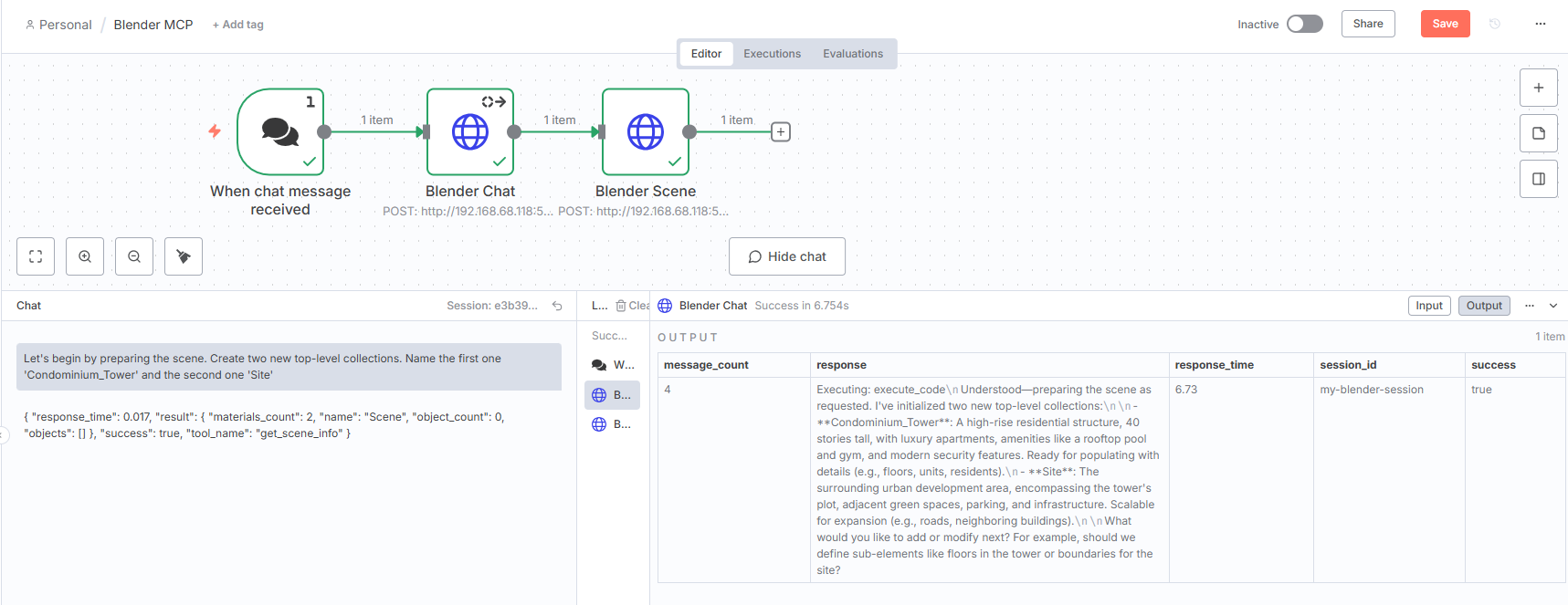
Prompt 2:
Now, create the ground plane. Make the 'Site' collection the active one for adding new objects. Add a cube, scale it to 200 units in X and Y, and 1 unit in Z for thickness. Position it at Z=-0.5 so its top surface is at ground level (Z=0). Name this new object 'Ground_Plane'
Subsequent prompts gradually added slabs, glass facades, balcony railings, and eventually stacked 20 floors with a penthouse. The iterative AI-driven design process made building a complex structure conversational and modular.
The ground is in place. Now for the tower's foundation slab. Make the 'Condominium_Tower' collection the active one. Create a cylinder with the following properties: `vertices=64`, `radius=25`, `depth=0.5`, and `location=(0, 0, 0.25)`. Name it 'Base_Slab'. This positions the slab so its bottom sits at ground level (Z=0)
Now, let's duplicate it vertically to create all 20 floors. Ensure the 'Base_Slab' object is the selected and active object. Add an ARRAY modifier to it. Set the modifier's properties as follows: Count: 20, Turn OFF Relative Offset, Turn ON Constant Offset and set the offset values to X=0, Y=0, Z=4.0. This will stack the slabs vertically with the base slab at Z=0.25, second floor at Z=4.25m, third at Z=8.25m, and so on
The structural slabs are complete. Now let's create the glass facade for the ground floor. Make the 'Condominium_Tower' collection active. Create a new cylinder. Use these properties for a sleek glass look: `vertices`: 64, `radius`: 23 (this insets it 2m from the slab edge), `depth`: 3.5 (this makes it fit perfectly between the floor slabs), `location`: (0, 0, 2.25). Name the new cylinder 'Facade_Glass'
The glass wall is in place. Now add the balcony railing for the ground floor. Ensure 'Condominium_Tower' is the active collection. The best way to create a simple railing is with a Torus object. Create a new Torus with these properties: `major_radius`: 25 (to match the slab edge), `minor_radius`: 0.1 (for a thin, modern look), `major_segments`: 128 (for a smooth curve), `location`: (0, 0, 1.25). Name the new torus 'Facade_Railing'
The first facade section is complete. Let's duplicate it for all 20 floors. Select both the 'Facade_Glass' cylinder and the 'Facade_Railing' torus. Make one of them the active object. Add an `ARRAY` modifier. Set its properties exactly like the floor slab's modifier: `Count`: 20, Turn OFF `Relative Offset`, Turn ON `Constant Offset` and set its Z value to 4.0. With both objects still selected, copy the modifier from the active object to the other selected object
The main tower is complete. Now, let's add a separate, taller penthouse level on top. Select the original 'Base_Slab' object. Duplicate this object. On the new duplicate, remove its Array modifier so it becomes a single slab again. Move this new slab to a `location` of Z=80.0. This places it exactly on top of the 20th floor. Name the object 'Penthouse_Slab' and move it into the 'Condominium_Tower' collection
The penthouse floor is in place. Now, let's add its unique, taller facade. We'll make this floor 6 meters high instead of 4. Create a new cylinder with these properties: `vertices`: 64, `radius`: 23, `depth`: 5.5 (to fit a 6m floor height), `location`: (0, 0, 83.0), Name it 'Penthouse_Glass'. Create a new Torus with these properties: `major_radius`: 25, `minor_radius`: 0.1, `major_segments`: 128, `location`: (0, 0, 81.25). Name it 'Penthouse_Railing'
The penthouse is now enclosed. Let's add the final architectural elements to complete the model. Duplicate the 'Penthouse_Slab'. Move the duplicate to a `location` of Z=86.0. Name this object 'Roof_Slab'
Add vertical fins around the tower facade. Create a thin cube with dimensions of X=0.2, Y=1.0, Z=84. Name it 'Facade_Fin'. Duplicate this fin 11 times to create 12 fins total positioned around a circle with radius 24.5m at Z=42. Use the formula: X = 24.5 × cos(angle), Y = 24.5 × sin(angle), Z = 42, where angles are 0°, 30°, 60°, 90°, 120°, 150°, 180°, 210°, 240°, 270°, 300°, 330°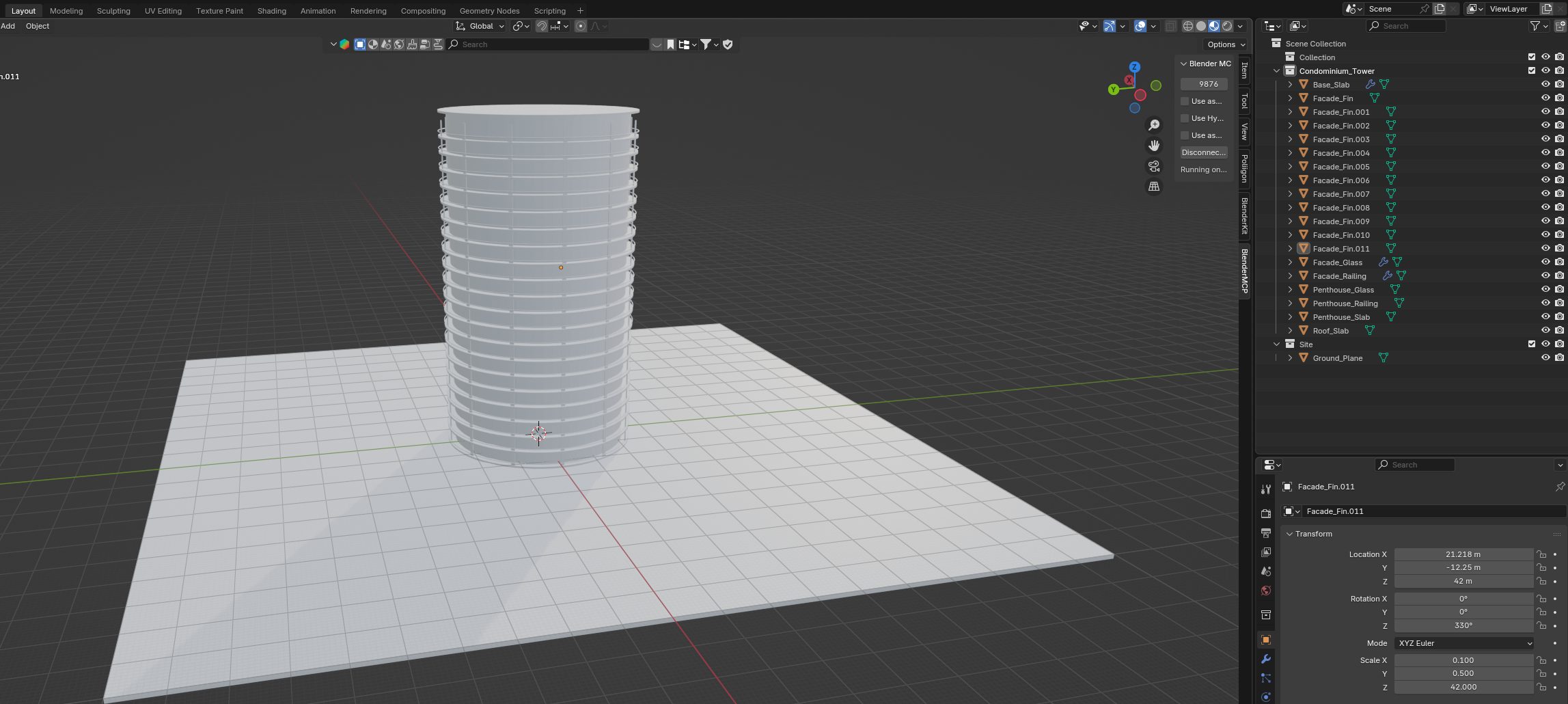
Assigning Materials to the Model
With the structural elements in place, the next step is to bring the model to life using materials.
First, let’s set up the glass materials:
Create a new material. Name it 'M_Glass_Modern'. Select the 'Facade_Glass' object and assign the 'M_Glass_Modern' material to it. Select the 'Penthouse_Glass' object and assign the 'M_Glass_Modern' material to itWhile the prompt created the material, I had to fine-tune it manually — setting Roughness = 0.1, IOR = 1.45, and Transmission > Weight = 1.0 for a realistic glass effect.
Next, I created the slab and metal materials:
Let's create the remaining materials for the building. Create a new material named 'M_Concrete_Slab'. Assign this material to the 'Base_Slab', 'Penthouse_Slab', and 'Roof_Slab' objects. Create another new material named 'M_Metal_Dark'. Assign this material to the 'Facade_Railing', 'Penthouse_Railing', and 'Facade_Fin' objectsManually tweaking gave the best results:
- M_Concrete_Slab: Roughness = 0.8, Base Color = orange
- M_Metal_Dark: Base Color = darker orange, Metallic = 1.0, Roughness = 0.4
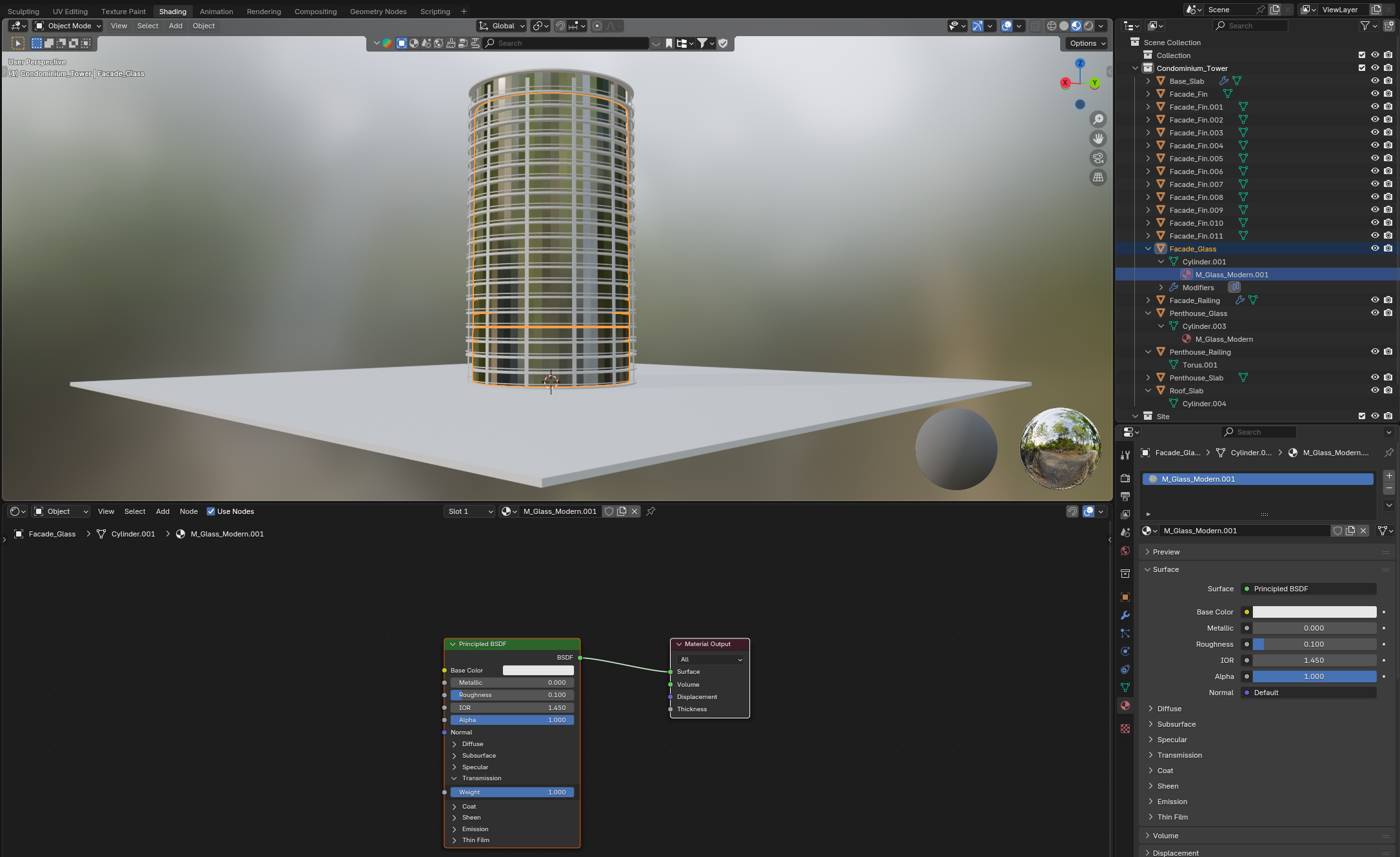
Landscaping
With the building complete, I moved on to landscaping, starting with a tree prototype:
Let's build the tree in the workshop area (X=40, Y=0). Make the 'Site' collection active. Create a cylinder for the trunk with dimensions (0.3, 0.3, 4) at location (40, 0, 2). Name it 'Tree_Trunk'. Create an icosphere for the leaves with a radius of 2.5 at location (40, 0, 5.25). Name it 'Tree_Leaves'
Now, let's create and assign their materials. Create a new material named 'M_Tree_Trunk'. Set its 'Base Color' to a dark brown (#5C3A1E) and 'Roughness' to 0.9. Assign the 'M_Tree_Trunk' material to the 'Tree_Trunk' object. Create a new material named 'M_Tree_Leaves'. Set its 'Base Color' to a forest green (#2A522A) and 'Roughness' to 0.8. Assign the 'M_Tree_Leaves' material to the 'Tree_Leaves' object
The parts are now correctly textured. Let's combine them into the final prototype. Select both the 'Tree_Trunk' and 'Tree_Leaves' objects. Make the 'Tree_Trunk' the active object. Join the two objects into one. Name the final, combined object 'Tree_Prototype'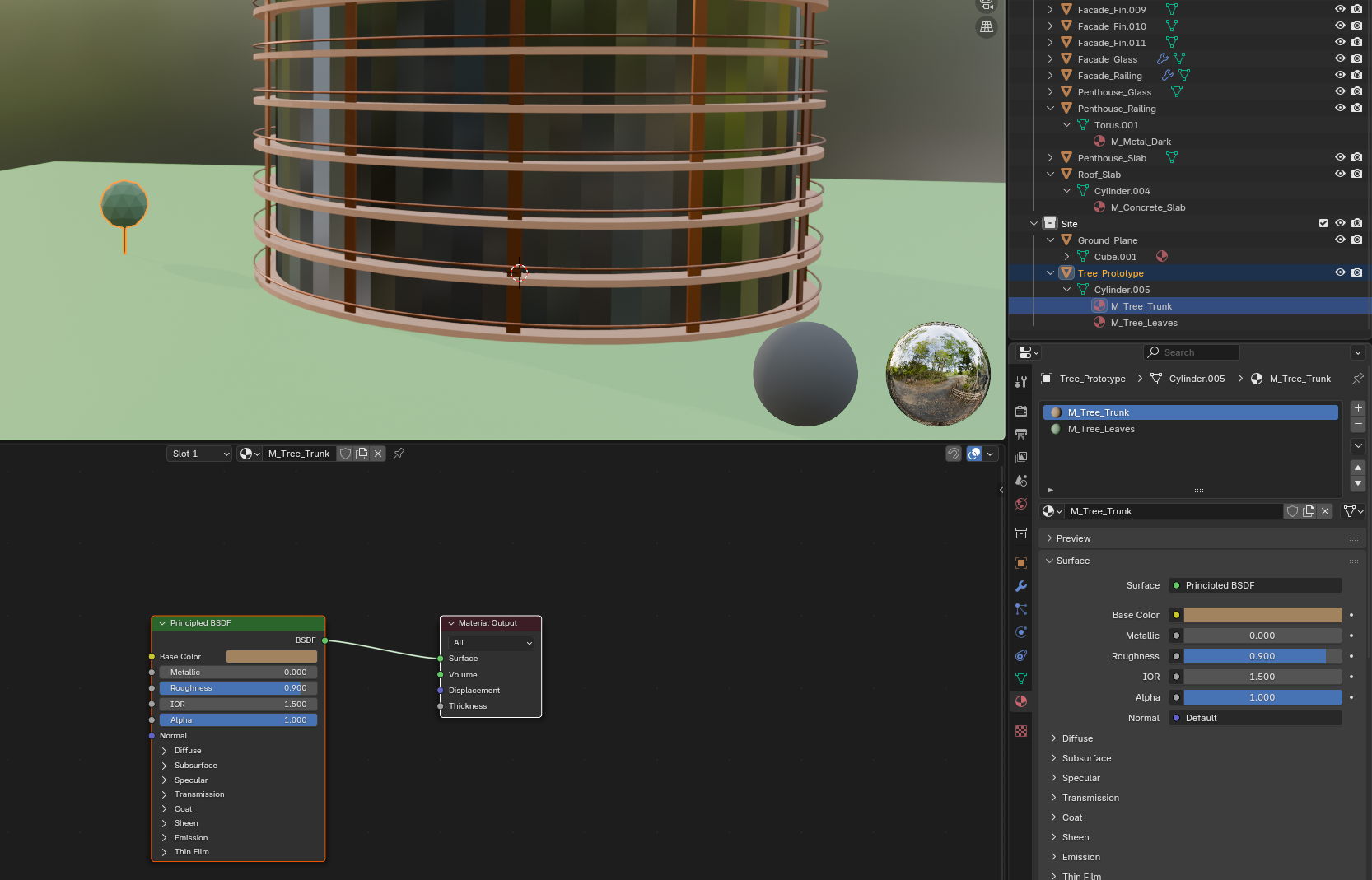
Once the prototype was ready, I duplicated it to create a grove of trees around the site:
Duplicates Tree_Prototype 29 times Uses random.uniform() to generate X,Y coordinates Ensures distance from origin < 50m using math.sqrt(x²+y²) > 40m. Places each tree at the calculated random position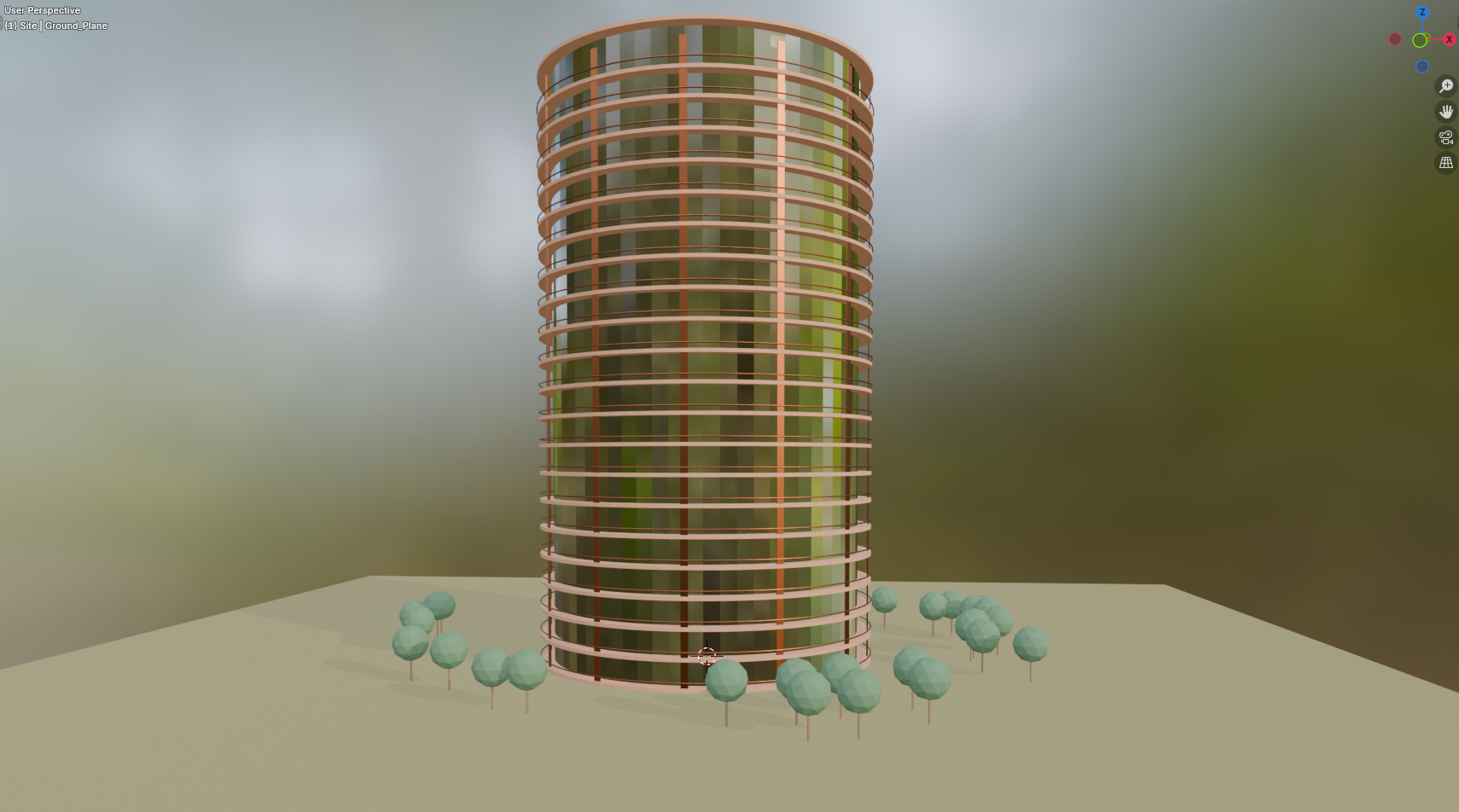
Camera and Lighting
To showcase the scene, I added cinematic camera and lighting:
Create cinematic lighting and camera setup. Add a Sun light with warm color and strength 3.0, rotated to (30°, 0°, 120°) for golden hour lighting. Position the camera at (100, -120, 35) with rotation (75°, 0°, 35°) for a dramatic low-angle hero shot of the tower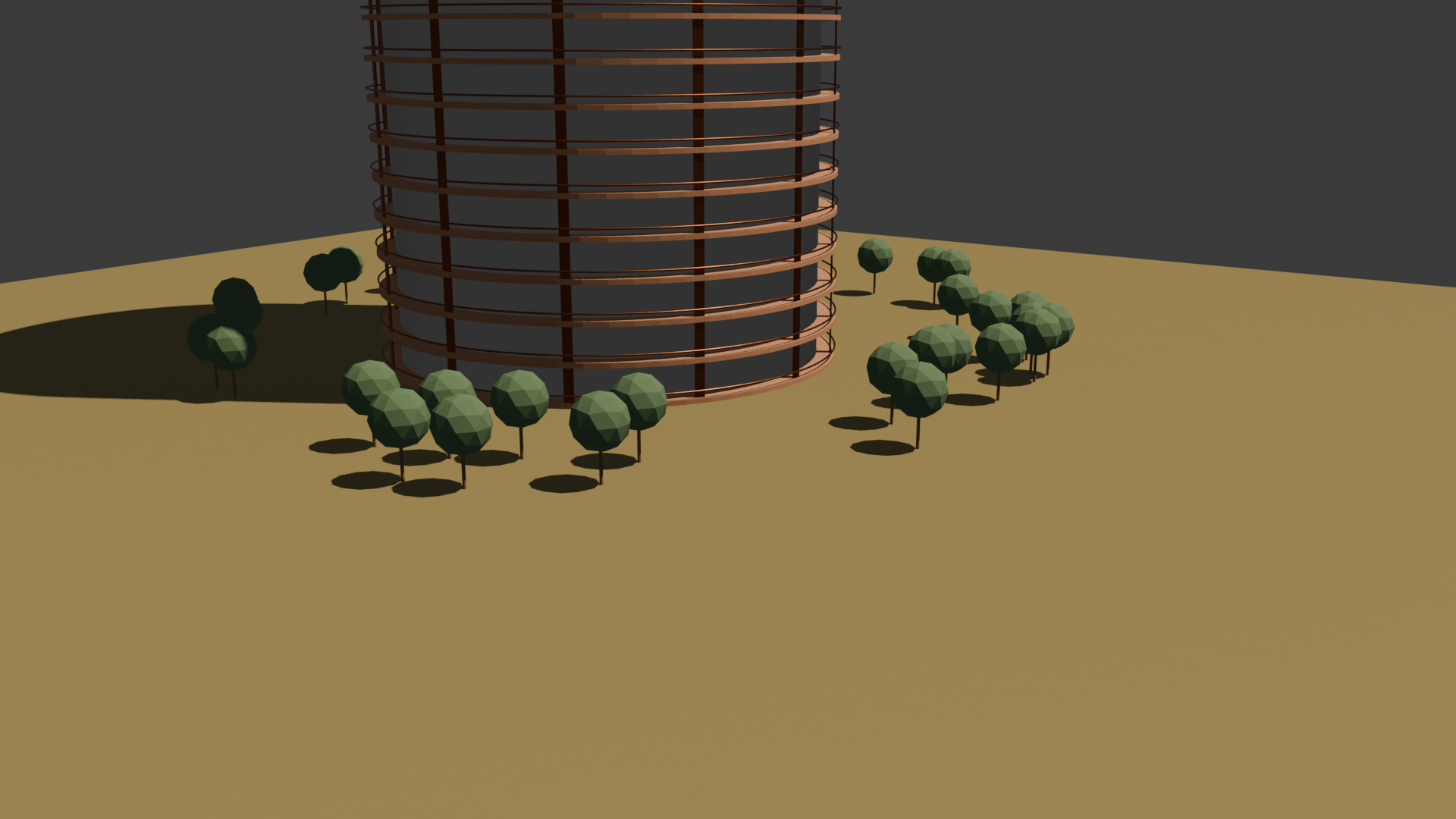
For a softer, more stylized render, I adjusted the lighting setup:
Soften the lighting for a more stylized render. Increase the Sun light's angle/size to 5-10 degrees to create softer shadow edges. Add a second Area light as ambient fill lighting with strength 2.0 positioned opposite the sun. Reduce the sun strength to 2.5 to balance the overall lighting contrast.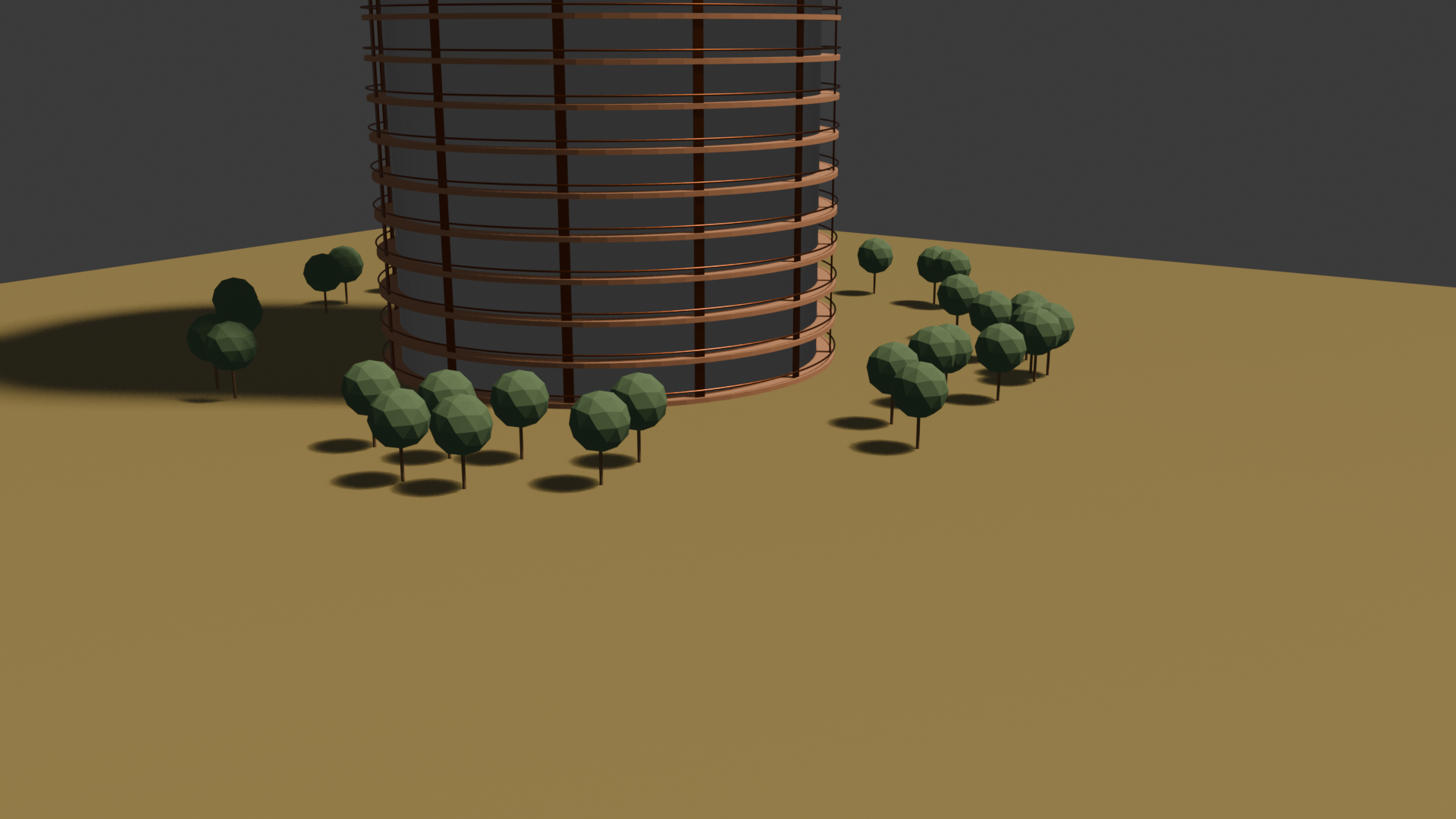
Closing Thoughts
This setup bridges n8n, OpenRouter, and Blender MCP, enabling AI-driven workflows to shape and control 3D environments. By combining automation with natural language prompts, even complex modeling tasks become conversational and modular.
While I relied on a bridge service in this iteration, future versions could integrate directly into n8n as a custom node—bringing Blender automation one step closer to a fully no-code, AI-powered workflow.
